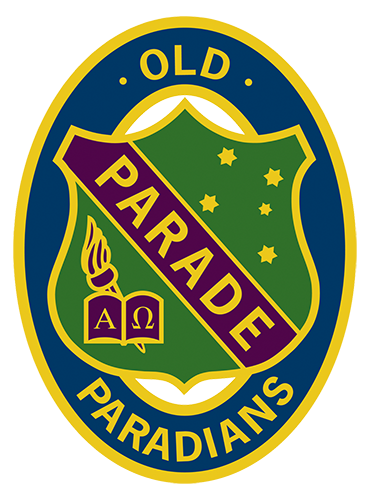

A few weeks ago, Craig Sandford emailed Old Paradians Central from London to advise that he would shortly be making a pilgrimage to France and Belgium.
Craig wrote to ask if the association could possibly provide him with
the names of those Old Boys of the College who lost their lives there
through the
course of the War to end all Wars.
“If you do have that listing of OP vets that served on the Western
Front, I can then cross-check against the Commonwealth War Graves
Commission listings,
and hopefully be able to stop at the relevant cemeteries whilst
taking some friends to view the various battle sites,” Craig wrote.
True to his word, Craig visited memorials in Fromelles, Le Hamel,
Menin Road, Pozieres Windmill and Villers-Bretonneaux, and found what
became of 12 Old
Paradians who paid with their lives in World War I – Raphael
Bradley, Richard Cahill, Thomas Cashman, John Flynn, John Houlihan,
Patrick Lynch, Eric
McClelland, Hector McFarlane, Francis Sheahan, John Smith and James
Tevlin.
Craig has since forwarded his photographs of the final resting places
of these young men. One such man was 20 year-old Richard Nicholas
Cahill, who on
July 24, 1916 died in Boulogne Hospital of gunshot wounds to his
chest and forearm suffered five days previously in the Battle of
Fromelles.
Richard, who was promoted to Acting Sergeant on the day of his death,
was interred at the Boulogne Eastern Cemetery, in Plot 8, Row A, Grave
No. 141.
In part two of this interview, Craig explains his motivation to honour those who gave their tomorrow so that we may have our today.
2017 found me thinking a bit more about being away from home, and
I remembered watching the dawn service at Villers-Bretonneux on the ABC
several years back. Carmel and I had visited the Australian memorial
there on a previous holiday in France, and I thought about driving along
the Western Front and being surprised at the sheer number of cemeteries
– let alone the number of graves within each of them. I struggled to
try and understand what these soldiers would have been experiencing, so
far from home, but with a comfort of having the familiarity of other
Aussies around you. I decided to attend this year’s dawn service partly
to honour them, but also to experience another connection with
travelling and ex-pat Aussies.
I haven’t found any direct family connection to the veterans of
WW1, but being in the presence of so many who had fallen and the various
monuments around France listing the names of those who had made the
ultimate sacrifice made me think of the honour boards back at Parade.
When a friend from Darwin asked to visit some of the battle sites their
family had fought at during a trip to Europe, I wondered how much detail
we had of those listed on the boards. An enquiry to Tony De Bolfo
uncovered that a significant amount of work had been performed by his
mother in capturing details of old boys that had fallen at the Western
Front. I thought my visit to the area would be an ideal time to capture
some images of where they had been laid to rest, or mentioned on honour
boards when their bodies had not been identified or recovered.
I have now visited the Somme Valley three times, and driven along
the Belgian and French parts of the Western Front a couple of times.
The first time, I remember being surprised to see German War Cemeteries,
but naturally there are at least two sides to a war, and of course all
sides suffer tremendous losses. The impressive part to recognise is that
the German and the other Central Powers cemeteries are managed with as
much care by the French as the Commonwealth and Allies’ cemeteries.
Not long into any trip to the area is a strong feeling of being
overwhelmed by the sheer number of cemeteries. Some are relatively
small, and only contain a 100 or so graves, others – particularly back
in the larger towns behind the front where the hospitals would have been
based - the graves number in their thousands. It doesn’t take long for
your mind to then grasp the hundreds of thousands of graves that are
here.
Such thoughts prompt feelings of regret at the sheer waste of the
world’s youth, some anger when you read about some of the battles that
were almost designed to fail, but then some pride in those who made the
decision to travel to the other side of the world and defend the
Belgians and French from invasion. It is also amazing to see the respect
given by both the Belgians and French to those who came. Towns like
Villers-Bretonneux honour not only those sacrifices made by those who
fought, but then also the post-war efforts to rebuild their town.
Victoria - as a state – funded the rebuilding of the town hall and
church, and Victorian school children raised the funding to rebuild the
primary school. Such pride is then tempered when then also noticing that
some buildings and memorials bear the scars of damage received when
fighting in the Second World War surfaced in the area.
Finishing the trip left me contemplating what could have been if I
had have been born in a different era. How different would have those
old boys who signed up been from me? Were they looking for a bit of
adventure? Were they fascinated by the different cultures they
experienced in those travels? What were their dreams for their lives
before the war broke out? Unfortunately some of those dreams weren’t
realised. Recognising those old boys in a small manner has been an
honour. I hope establishing a record of their lives and final resting
places gives us all an opportunity to reflect on their actions, and
remember to live our lives to the full.